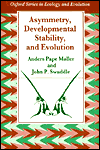Asymmetry, Developmental Stability, and Evolution
Why does nature love symmetry? In this up-to-date review of symmetry and its evolutionary implications, Anders Møller and John Swaddle argue that symmetry is related to genetic stability and fitness and that symmetric individuals appear to have quantifiable and significant advantages over their asymmetric counterparts. In contrast, asymmetry, a common measure of developmental instability, is the result of environmental or genetic disruptions of developmental processes, such as pollutants,...
Search in google:
Why does nature love symmetry? In this up-to-date review of symmetry and its evolutionary implications, Anders Møller and John Swaddle argue that symmetry is related to genetic stability and fitness and that symmetric individuals appear to have quantifiable and significant advantages over their asymmetric counterparts. In contrast, asymmetry, a common measure of developmental instability, is the result of environmental or genetic disruptions of developmental processes, such as pollutants, competition, parasitism, inbreeding, genetic mutation, and hybridization. Møller and Swaddle maintain that deviations from morphological symmetry are important factors in social or sexual situations: animals may be able to use symmetry as an honest indication of quality when assessing potential mates or competitors. This comprehensive review of the literature on developmental stability will be important reading for students and researchers in the fields of ecology, evolutionary biology, genetics, and animal behavior.
1Asymmetries and developmental stability12Ontogeny of asymmetry and phenodeviants373Developmental stability and mode of selection674Adverse environmental conditions and evolution855Causes of developmental instability. I. Genetic factors1116Causes of developmental instability. II. Environmental factors1347Developmental instability and performance1548Developmental stability and signalling1789Developmental stability and fitness207References231Author index273Taxonomic index283Subject index289








